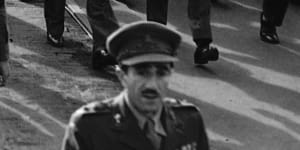AUSTRALIA REMEMBERS FALLEN HEROES
Parade of Anzacs Stirs Crowd
Across Australia yesterday,many thousands of ex-servicemen of four wars paid humble tribute to fallen comrades in Anzac Day remembrance.

The 1952 Anzac Day march in Melbourne.The Age Archives
In Melbourne,30,436 men marched to the Shrine of Remembrance to pay their tributes in cool weather under a shy autumn sun. More than 100,000 people watched the march.
At the Shrine of Remembrance in Melbourne,the Governor of Victoria (Sir Dallas Brooks),said:“Hold fast to the Anzac spirit… Its qualities can meet and overcome whatever problems beset man.”
Melbourne’s remembrance began with the traditional dawn service at the Shrine,which was this year attended by 3000 ex-servicemen.
The old atmosphere of the dawn stand-to had not faded. Cigarettes burned in the half-light,and there was an aura of deep expectancy in the simplicity of the service.
From the first note of the bugle there was an intense quiet among the assembled men.
Men who had talked of other dawns huddled under their overcoats and moved up to attend the simple service of remembrance.
Sir Dallas Brooks placed his wreath above the tomb of the Unknown Soldier,and another Anzac Day had begun.
VETERANS OF FOUR WARS MARCH
The 37 years that have passed since the first Australians landed at Anzac Cove had thinned the ranks of the First A.I.F.
But time had not effaced the pride on the faces of those left to carry on the pilgrimage. The “original Anzacs” who set the seal on a fine military tradition marched well.
Before the march began,crowded trains and trams to the city gave ample testimony that the traditions of Anzac were being well remembered.
Polished boots,bright shining medals clinking on best suits,an easy camaraderie and an intangible resurgence of the spirit of the battlefields were everywhere.
There was much to think about as the old battalions reformed. There were empty spaces in the ranks as there had been so many times before.
The blinded soldiers,each on the arm of another more fortunate Digger,shook hands with the same verve as the rest as old comrades caught sight of them.
As the Fifth Division of the A.I.F. closed its ranks one man turned to his two cobbers,“I’ve got my cab around the corner,” he said. “Let’s give away the march and dodge out to Heidelberg.”
So the three men made their own small sacrifice. They forewent the march and drove to Heidelberg Military Hospital.
There they squatted on beds and talked to men still suffering from grievous wounds of battle.
Their names? Jack Sutherland,Bill Walters and “Slim” Salmon. “We’re all fifth divvy,” they said. “No need to say anymore. It’s just an Anzac Day thought.”
Policemen Lead the Way
So,promptly at 1.30 p.m.,the great march of remembrance began. Four policemen,sitting proud and erect on their white chargers,led the way. Each was an ex-serviceman.
None who watched the march that followed could escape the same ennobling thought. War was the great leveller. The intensity of shellfire had brought all men to their station.
Men in well-cut suits and homburg hats were proud to march behind a man whose shoes lacked acquaintance with the boot mender.
As only Australians can,they marched with that easy gait and careless indifference to discipline that is the hallmark of Australian arms.
Before the Second A.I.F.,came an earlier generation that had known its suffering and endured it well.
And before the First A.I.F. came the vanguard. An airman,small and erect,and as determined as the R.A.A.F. itself,led the way.
Air Marshal George Jones,C.B.,C.B.E.,D.F.C. – a veteran of Gallipoli where Anzac was defined so brilliantly — led the way.
Behind him came the blinded ex-servicemen,marching valiantly towards a Shrine which they have never seen,but with whom message they are so intimate. Marching confidently. Marching arm-in-arm with comrades they trusted in battle and trust now.
Then came the veterans of the Boer War,their battle flag rippling bravely in a southerly breeze,their shoulders hunched by time,their legs weary.
The man who carried the flag bent low to bear his tribute through the breeze as he marched through the crowded streets he evoked the first cheer of the many that greeted the march and spurred it on.
Next came the ranks of the nurses and the women’s services,tightly knit,smart,grey uniforms well pressed,marching well behind a band that stirred the memories with the tune of Keep the Home Fires Burning.
Then the dark blue of the Navy,sailors marching as sailors can,bell-bottoms swinging,glistening,marching from the blue wastes of the Pacific,the grey waters of the Atlantic,the blood-stained depths of the Coral Sea to pay their remembrance.
First World War Men
Then into the long ranks of the men of the First World War,long enough to take 40 minutes to pass the saluting base.
Their tattered banners bore the hard-won honours of Gallipoli,of Ypres,of the Marne,of Mons,Passchendaele,and of New Guinea.
With them marched the New Zealanders in their pointed slouch hats,worthy partners in the great tradition that is Anzac. The thousands of faces that lined the route gave them an especial cheer.
And after them came another generation of Australian soldiers,the men of the Second A.I.F.,men who had scrawled the Anzac tradition on new pages of history in the Markham Valley,at Altape,at Wau,at Tobruk,and a hundred other places of battle.
With them marched men who were proud to share the tradition of Anzac,Greeks,Americans and British ex-servicemen.
Near the end of the procession came the 50-strong “Korea Mob” – the latest Australians to add their name to the long scroll of history which has recorded Australia’s feat of arms.
Their heads were high,their eyes bright. The thousands that cheered them saw in them an undying history that began at Anzac Cove.
Finally came the men of the R.A.A.F. behind their squadron banners,fighter pilots,bomber crews,pathfinders,ground crew. It was a fine end to an inspiring march.